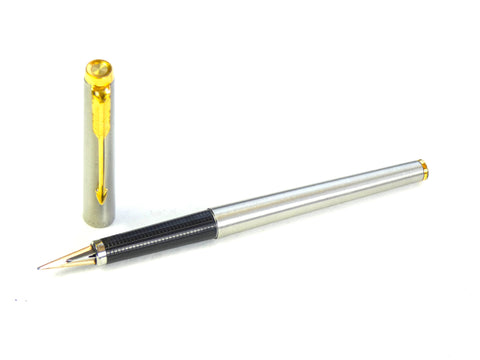The Parker 180, for a long time considered a 'sleeper' in terms of collectability, now seems to have been rediscovered and has 'woken up'.
The pen was introduced in 1977 and advertised as having “One nib. One point. Two ways to write.” This is because the pen is designed to be used “right side up” and “upside down” with two different line widths. This claim is perfectly justified but, I have to say that, in my experience, the 180 almost always writes better the 'right way up'.
Parker had dealt with numerous complaints from customers using Gold nibbed pens, such as the Parker 75, which were caused by the user, being more accustomed to pressing hard with a ballpoint, bending the Gold nib. Parker were determined to offer a large Gold nib on the 180 so it was reinforced from above by a metal strut and from below by a robust feed. The result is the distinctive, lethal looking, and effective double sided 180 nib assembly. Later pens used a steel nib but the feed arrangement, presumably now not so critical, was retained.

The 180 has a cross hatched, plastic gripping section and a "winged" tassie that was actually designed to "hook" in the cap when it was posted on the back, to prevent the pen body from scratches while writing.
In 1986 the 180 was discontinued and was replaced with the simillar Classic. The naming of the pen was confusing as Parker had already used 'Classic' a number of times for versions of other models.
The Parker Classic retained the overall shape and dimensions of the Parker 180 but lacked the 'wow factor' of the lethal nib assembly.


It is unfortunate that many people who should, and often do, know better persist in describing the Classic as a 180. The Classic is a fine pen in it's own right but it is not a 180, describing it as such for pecuniary reasons is confusing and unfair.
The Parker 180 was made in a wide range of finishes, including some attractive lacquered effects produced in Meru, France. These are, undoubtedly, beautiful pens but lack the robustness of the original Flighter models, one has to be a bit more careful about how the pen is used.

A Lacque Thuya 180

And the beautiful green striped Malachite.
The Parker 180 was always recognised as a pen with individuality and a certain 'quirkiness', it has undergone a huge surge in popularity among fountain pen enthusiasts of late. Demand is certain to outpace supply, there is, after all, no new supply, just recycling.
